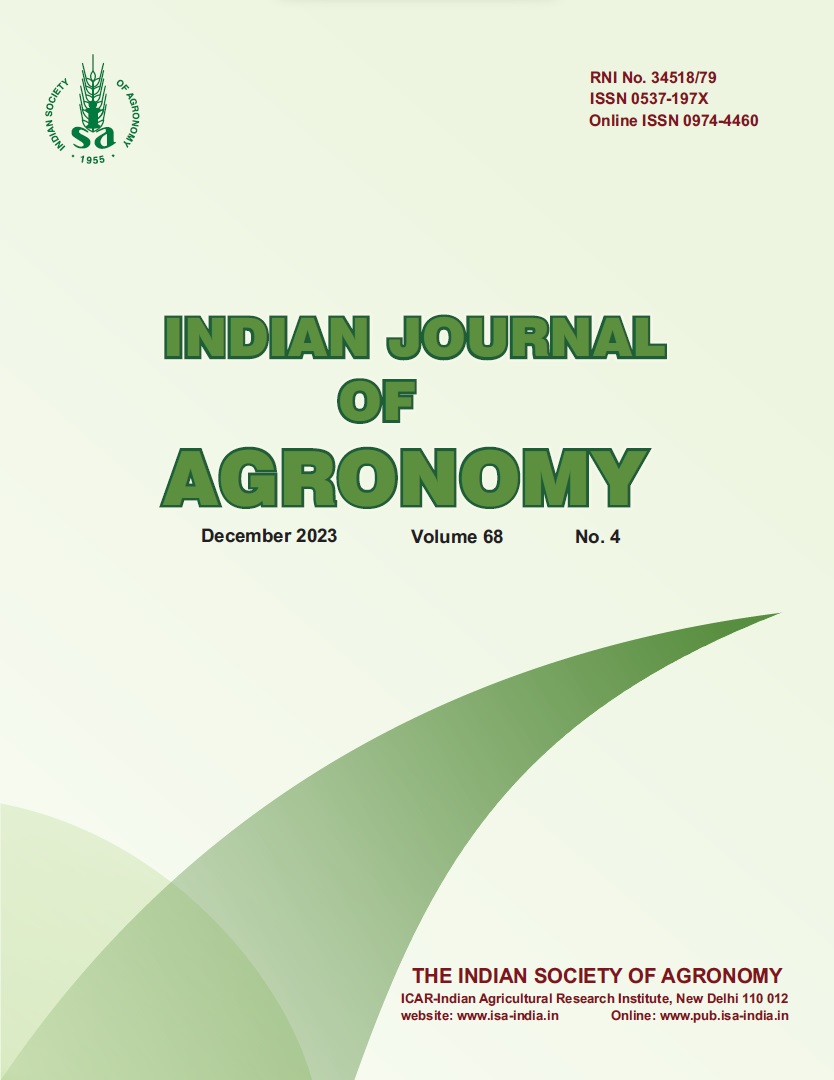Organic farming practices in rainfed lowland rice in hill zone of Karnataka, India
DOI:
https://doi.org/10.59797/ija.v68i4.5452Keywords:
Eupatorium, Lowland Rice, Organic farming, RDF, Soil fertilityAbstract
A large-scale field trial was conducted at Agricultural Research Station (Paddy), Sirsi of the University of Agricultural Sciences, Sirsi, Karnataka, India, during 2004–15 on a fixed site, to study the effect of different organic farming practices on productivity of rice (Oryza sativa L.) under inorganic and integrated nutrient-management practices. The trial consisted of 5 treatments, viz. T1 , Organic [75% N through organic manures + 100% organic plant protection (PP) measures]; T2, organic [100% N through organic manure + 100% organic plant protection (PP) measures]; T3 , integrated nutrient management [50% N through organic manures + 50% RDF + integrated PP measures]; T4 , inorganic treatment [recommended dose of fertilizers (RDF) alone + inorganic PP measures]; and T5 , recommended practice (RDF + FYM 10 t/ha + integrated PP measures). The rice variety ‘Abilash’ was grown during the rainy (kharif) season with these treatments. At the end of 12th year, i.e. during 2015, the grain yield recorded in treatment T2 (6.418 t/ha) was the maximum and was found on a par with T5 (6.328 t/ha). How-ever, the straw yield was the maximum in T5 (7.577 t/ha), being at par with T2 (7.494 t/ha). The net returns realized were significantly highest with treatment T2 (`41,045/ha) compared to all the other treatments. The soil organic carbon (0.77%), available major (221.2, 22.0 and 67.0 kg/ha of N, P and K, respectively) and micro-nutrients (515.5, 100.8, 5.6 ppm of calcium, magnesium and zinc, respectively and 7.6 kg/ha of sulphur) were also higher with treatment T2 .
References
Debjani Sihi, Biswanath Dari, Dinesh K. Sharma, Himanshu Pathak, Lata Nain and Om Parkash Sharma. 2017. Evaluation of soil health in organic vs. conventional farming of basmati rice in North India. Journal of Plant Nutrition and Soil Science 180(3): 389–406.
Eyhorn, F., Van den Berg, M., Decock, C. and Maat, H. 2018. Does organic farming provide a viable alternative for smallholder rice farmers in India? Sustainability 10(12): 4,424.
Manjappa, K. 1999. Sustainable production of planted and ratoon crop of hybrid rice under hill zone of Kanataka. Ph.D. thesis, University of Agricultural Sciences, Dharwad, Karnataka, India (unpublished).
MoA & FW. 2020. Agricultural Statistics at a Glance 2019. Ministry of Agriculture and Farmers Welfare, Department of Agriculture, Cooperation and Farmers Welfare, Government of India, New Delhi p. 48.
Moola Ram, Devari, M.R. and Sharma, S.N. 2011. Effect of organic manures and biofertilizers on basmati rice (Oryza sativa L.) under organic farming of rice–wheat cropping system. International Journal of Agriculture and Crop Sciences 3(3): 76–84.
Pandey, N., Verma, A.K., Anurag and Tripathi, R.S. 2007. Integrated nutrient management in transplanted hybrid rice. Indian Journal of Agronomy 52(1): 40–42.
Patil, V.C. 2008. Declining factor productivity and improving nutrient-use efficiency. (In) Proceedings of the National Symposium on New Paradigms in Agronomic Research, held during 19–21, November 2008 at Navasari, Gujarat, India.
Prakash, Anand, Singh, V.P., Kumar, Rajeev and Singh, I.P. 2008. Effect of organics and micronutrient fertilization in rice (Oryza sativa L.)–wheat (Triticum aestivum L.) cropping system. (In) Proceedings of the National Symposium on New Paradigms in Agronomic Research, held during 19–21 November 2008, Navasari, Gujarat, India.
Rao, A.U., Murthy, K.M.D., Sridhar, T.V., Raju, S.K. and Lakshmi, D.A. 2014. Studies on performance of organic farming and chemical farming in rainy season rice. International Journal of Plant, Animal and Environmental Sciences 4(4): 202–206.
Sihi Oebjani, Sharma, O.K., Pathak, H., Singh, V.V., Sharma, C.P., Lata, Chaudhary, A. 2012. Effect of organic farming on productivity and quality of basmati rice. ORYZA- An International Journal on Rice 49(1): 24–29.
Singh Y.V. and Dhar Dolly, W. 2011. Influence of organic farming on soil microbial diversity and grain yield under rice–wheat–green gram cropping sequence, ORYZA–An International Journal on Rice 48(1): 40–46.
Singh, Y.V., Singh, B.V., Pabbi, S. and Singh, P.K. 2007. Impact of Organic Farming on Yield and Quality of Basmati Rice and Soil Properties. (http://orgprints.org/view/projects/wissenschaftstagung-2007.html)
Stockdale, E.A., Lampkin, N.H., Hovi, M., Keating, R., Lennartsson, E.K.M., Macdonald, D.W., Padel, S., Tattersall, F.H., Wolfe, M.S. and Watson, C.A. 2001. Agronomic and environmental implications of organic farming systems. Advances in Agronomy 70: 261–327.
Tao Li, Jusheng Gao, Lingyu Bai, Yanan Wand, Jing Huang, Mahendar Kumar and Xibai Zeng. 2019. Influence of green manure and rice straw management on soil organic carbon, enzyme activities, and rice yield in red paddy soil. Soil and Tillage Research 195: 104–428.
Teodoro, C. and Mendoza. 2004. Evaluating the benefits of organic farming in fice agroecosystems in the Philippines. Journal of Sustainable Agriculture 24(2): 93–115.
Tripathi, M.K., Majumdar, B., Sarakar, S.K., Chowdhary, H. and Mahapatra, B.S. 2009. Effect of integrated nutrient management on sunnhemp (Crotalaria juncea) and its residual effects on succeeding rice (Oryza sativa) in eastern Uttar Pradesh. Indian Journal of Agricultural Sciences 79(9): 694–698.
UAS. 2004. Package of Practices for High Yields. University of Agricultural Sciences, Dharwad, Karnataka, India.
Yadav, D.S., Kumar Vineet and Yadav, Vivek. 2009. Effect of organic farming on productivity, soil health and economics of rice (Oryza sativa)–wheat (Triticum aestivum) system. Indian Journal of Agronomy 54(3): 267–271.






